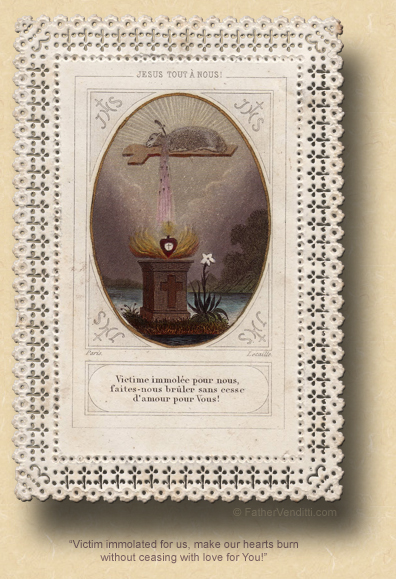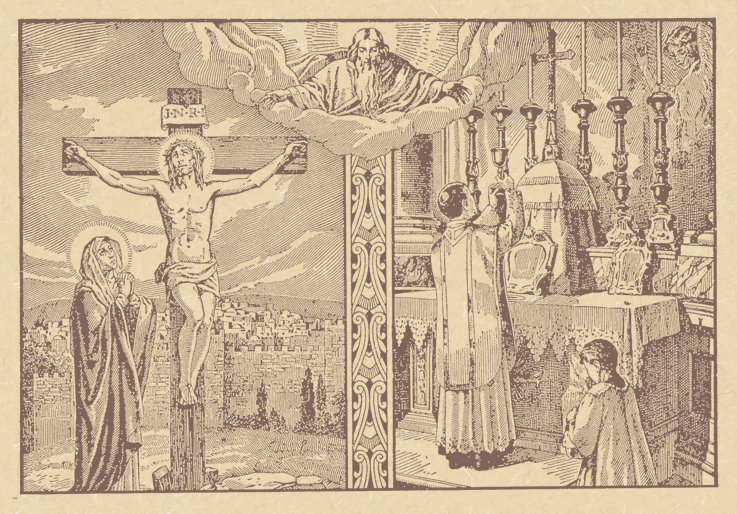The Eternal Link Between the Altar and the Confessional.
The Fifth Thursday of Lent.*
Lessons from the feria, according to the ordinary form of the Roman Rite:
• Exodus 32: 7-14.
• Psalm 106: 19-23.
• John 5: 31-47.
Lessons from the feria, according to the extraordinary form of the Roman Rite:
• IV Kings 4: 25-38.
• Psalm 73: 20, 19, 22.
• Luke 7: 11-16.
FatherVenditti.com
|
 9:13 AM 3/15/2018 — In the Gospel lesson of yesterday's Mass we heard the first half a lecture given by our Lord on the subject of Soteriology, which is an unfamiliar word for the study of salvation (from the Greek σωτηρία meaning “deliverance” or “salvation”). I didn’t preach about it, choosing instead to focus on our first lesson from Isaiah; but, our Lord had focused primarily on His own role in salvation history, explaining to the Jews how it came about that God—meaning Himself—had to become a man because the sin of man required a penalty paid by a man. He angers the Jewish leaders with this first half of his class by his repeated use of the phrase: “Amen, amen, I say to you…,” which is an Old Testament formula used by God when speaking to Moses. Hence, their indignation at Him seeming to regard Himself equal with God … which, of course, He is, because He is God. Then He went on to make the seamless transition from referring to Himself as “Son of God” to “Son of Man”; this signifies the fact that His approaching death will satisfy the requirement of God's justice that a man pay for man's sins by reason of the fact that, when he dies on the cross, He will be fully a Man. 9:13 AM 3/15/2018 — In the Gospel lesson of yesterday's Mass we heard the first half a lecture given by our Lord on the subject of Soteriology, which is an unfamiliar word for the study of salvation (from the Greek σωτηρία meaning “deliverance” or “salvation”). I didn’t preach about it, choosing instead to focus on our first lesson from Isaiah; but, our Lord had focused primarily on His own role in salvation history, explaining to the Jews how it came about that God—meaning Himself—had to become a man because the sin of man required a penalty paid by a man. He angers the Jewish leaders with this first half of his class by his repeated use of the phrase: “Amen, amen, I say to you…,” which is an Old Testament formula used by God when speaking to Moses. Hence, their indignation at Him seeming to regard Himself equal with God … which, of course, He is, because He is God. Then He went on to make the seamless transition from referring to Himself as “Son of God” to “Son of Man”; this signifies the fact that His approaching death will satisfy the requirement of God's justice that a man pay for man's sins by reason of the fact that, when he dies on the cross, He will be fully a Man.
Today's half of the lecture introduces the concept of intercession, and is anticipated by our first lesson from Exodus. Moses stands before the Lord and intercedes with Him, that He might not punish His people for their infidelities: and he invokes some moving reasons: the good name of the Lord among the Gentiles, the faithfulness he himself owes to the Covenant made to Abraham and his descendants. And it works; God relents and forgives once more. Today's Psalm recounts in poetry what our first lesson described in narrative: “Then he spoke of exterminating them, / but Moses, his chosen one, / Withstood him in the breach / to turn back his destructive wrath” (Psalm 106: 23 RM3).
Of course, understood in this whole process of God threatening punishment, then Moses seeming to talk Him out of it, is the certainty that the mind of God is unchangeable. God doesn't change His mind;—what God does is known by Him through all eternity—but, He often does allow it to appear that His mind has been changed by prayer and pleading because of the spiritual benefit this has on us.
Christ's total self-surrender on our behalf, which reaches its culmination on Calvary, is really nothing more that the last and greatest example of God responding to the prayer and pleading of His people to save them from themselves. On Calvary, our Lord becomes both priest and victim: priest in that He is the one offering sacrifice, and victim in that He is offering Himself as the sacrifice. And this is exactly what is being reproduced for us every time we gather to offer together the Holy Sacrifice of the Mass.
In every true sacrifice there are four essential elements: a priest, a victim, an internal offering, and an external manifestation of that offering. In the Temple of Jerusalem, the priest was a member of the priestly class, such as Zachariah, the father of John the Baptist; the victim was either a lamb or a pair of turtle doves, such as those Joseph brought for the Presentation of our Lord; the internal offering was the intention of the one bringing the offering, such as Joseph fulfilling the command in Leviticus to offer his first born to the Lord; and the external manifestation was the blood of the lamb sprinkled on the altar and sometimes the people.  In the Holy Sacrifice of the Mass, Christ is all of them: He is the priest, He is the victim, He alone makes the internal sacrifice by freely willing His death on the Cross to make it all happen, and the external manifestation is the Blessed Eucharist we all receive and worship, which is Himself in the disguised from of bread and wine. In the Holy Sacrifice of the Mass, Christ is all of them: He is the priest, He is the victim, He alone makes the internal sacrifice by freely willing His death on the Cross to make it all happen, and the external manifestation is the Blessed Eucharist we all receive and worship, which is Himself in the disguised from of bread and wine.
He only had to do it once on the cross, but He makes the deliverance provided by that Sacrifice available to us by empowering others to stand in His place to offer that Sacrifice by proxy in His name, and those are the men that we call priests. But that's only a name: in reality there is only one Priest; we apply the name to these men because Christ allows us to, because it's the only word that accurately describes what it is they do in His name. And these men become worthy of this great role they play in salvation by imitating the One in Whose name they act: they must surrender themselves completely in just the same way that Christ did, and that's why there can be no such thing as a part-time priest.
Most of you are too young to remember it, but some twenty years prior to the Second Vatican Council there was an experiment in France called the “Worker-Priest Movement,” and the idea behind it was to do exactly what I just said was not possible. The goal was to make priests more accessible to the faithful and more in touch with the “common man”—whomever he may be—by taking the priest out of the rectory and making him live among the people in his own apartment, dressing like everyone else, taking a factory job or some other kind of manual labor job, but functioning as a priest more or less on Sunday. It was never an officially sanctioned movement, done without the permission of the Holy See in a few big city dioceses, principally in and around Paris; but, it failed miserably. In fact, the Holy See didn't even get a chance to step in a stop it: it died on it's own by attrition, and you don't have to be a genius to figure out why: most of the men involved in it left the priesthood. In their attempt to be more in touch with their people, they ceased to be in touch with their Divine Master. That's because the Sacrifice of Christ as both Priest and Victim is only efficacious because it is both freely willed by Him and it is complete: He gives Himself totally to the Sacrifice, holding nothing back for Himself; hence, the man who would aspire to follow in His footsteps as a priest by proxy must give his whole life to it, and do nothing else, sacrificing his will to obedience, sacrificing his emotional life to solitude and celibacy, sacrificing the natural desire for home and hearth to going wherever he is sent.
But it is not only in offering sacrifice that the priest imitates the Lord; it is also in acting as intercessor, which is why Moses, even though he was not a priest, is also an image of the Holy Priesthood. Both while standing at the altar and while sitting in the confessional the priest pleads for us before God, even though, as I said, God already knows His pardon and forgiveness. But, just like any sacrifice, an act of intercession must also have an internal offering, and that internal offering must be made by us. It is made by our desire to not only confess our sins completely, but to do penance for them. And that is why there will always be an eternal link between the altar and the confessional: each one makes the other possible, and is why the external manifestation of the Sacrifice, which is the Blessed Eucharist, can only be received in the State of Grace, which is restored to us through sacramental absolution, which is only valid when accompanied by true contrition and a firm purpose of amendment.
So, as we enter this home stretch, if you will, of this holy season, may we continually make that internal offering, by examining our consciences often, confessing our sins completely, and receiving our Blessed Lord worthily, so that His death on the cross will have the desired effect of saving us from ourselves.

* Because Lent began on a Wednesday, today is the fifth Thursday. Cf. the post here under the heading "Hey, aren't you off by a week?" for an explanation of how the days of the liturgical calendar are rendered on this site as opposed to how they are designated in the Roman Missal.
|

